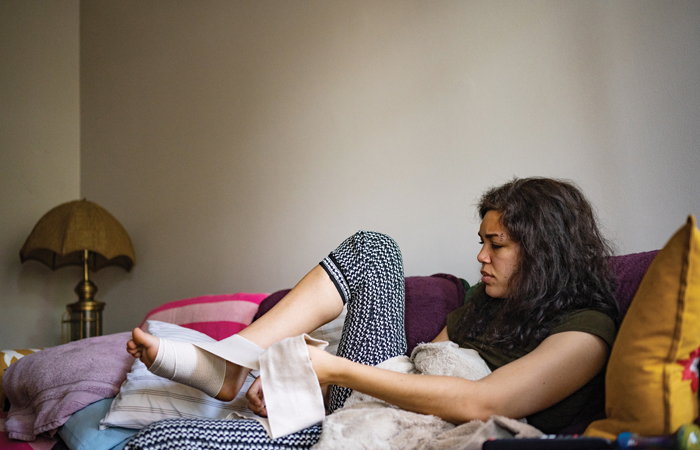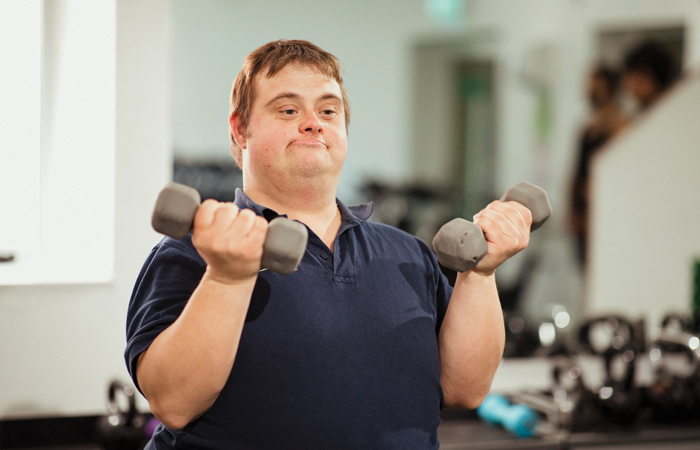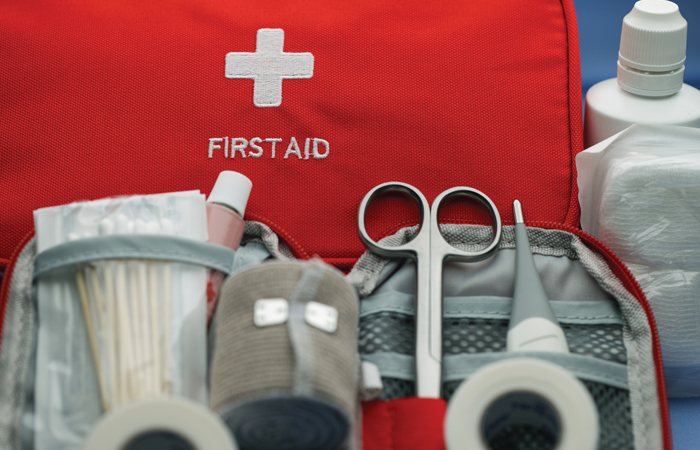In Conditions
Follow this topic
Bookmark
Record learning outcomes
According to statistics, we are far more likely to be injured at home than anywhere else, with The Royal Society for the Prevention of Accidents (RoSPA) estimating that around 2.7 million people in the UK require hospital visits following an accident in the home each year.
Since people suffering from minor injuries often present themselves in the pharmacy for advice or care, it’s important that pharmacy teams know about first aid, and are able to advise customers on how to treat themselves safely, as well as how and where to refer them to for more serious injuries.
“2.7 million people in the UK require hospital visits following an accident in the home each year”
Common first aid practices
Cuts and grazes are really common occurrences, especially among children.
“Pharmacy teams can give customers lots of advice about treatment for cuts and grazes,” says Jacquie Lee, medication safety officer and information pharmacist at Numark.
“The first thing they should do is clean the wound with mild soap and water or a saline solution and apply an antiseptic to reduce infection risk. It’s a good idea to cover the site with a sterile dressing or plaster to protect the area, and you can recommend non-stick dressings for larger grazes or hydrocolloid plasters for faster healing.”
Advise patients to monitor for signs of infection – such as increased redness, swelling, pus, or pain – and remind them they can come back into the pharmacy or call 111 if they have any concerns.
Knowing how to use bandages and slings effectively is an essential first aid skill, as correctly applied bandages can help reduce swelling, protect wounds from infection and immobilise injured areas, while slings offer crucial support to arms or shoulders that may be fractured or dislocated.
“Show customers how to apply compression bandages for support, ensuring they’re not too tight (check for numbness or colour change in extremities),” says Jacquie.
“When it comes to slings, advise on correct positioning, which is elbow at 90° and hand slightly elevated to reduce swelling and support healing. You should also encourage removing these at night unless otherwise advised, and wearing them less as healing progresses.”
Cardiopulmonary resuscitation (CPR) is a life-saving emergency procedure that combines chest compressions with rescue breaths (or compressions alone) to help maintain blood circulation and oxygen supply to the brain and vital organs when someone’s heart has stopped beating or they have stopped breathing.
“Pharmacy staff are not expected to perform CPR, unless they are a trained first aider,” says Jacquie, “but you can encourage customers to attend first aid or CPR training, such as via St John Ambulance or British Red Cross”.
“When it comes to slings, advise on correct positioning, which is elbow at 90° and hand slightly elevated”
CPR in five steps
The British Heart Foundation (BHF) offers some handy advice on how to do CPR on an adult in five steps.
1. Check for a response. Firmly shake the person’s shoulders and loudly ask if they’re okay
2. Call 999. If the person is unconscious and not breathing, or not breathing normally, start CPR
3. If there is someone with you, ask them to find a defibrillator
4. Start chest compressions. With the heel of your hand in the centre of their chest, press down smoothly and firmly at a rate of two per second. Try pushing to the beat of Stayin’ Alive by the Bee Gees
5. Use a defibrillator as soon as you can. Follow its instructions carefully while you continue to give CPR.
The BHF’s free interactive online RevivR course (bhf.org.uk/how-you-can-help/how-to-save-a-life/how-to-do-cpr/learn-cpr-in-15-minutes) enables anyone to learn CPR in 15 minutes and receive a CPR certificate. All that’s required is a mobile phone or tablet and a cushion to practice on.
St John Ambulance (sja.org.uk/courses/) and The Red Cross (redcross.org.uk/first-aid) also run first aid courses.
Common sports injuries
Sports injuries are a common concern for people of all ages and fitness levels and knowing how to manage them effectively can make a big difference to recovery time.
The PRICE technique is a widely recommended first aid approach for managing minor sprains and strains, helping to reduce pain, limit swelling, and speed up recovery. PRICE stands for protection, rest, ice, compression, and elevation.
- Protection involves preventing further injury, such as using a support or avoiding putting weight on the affected area
- Rest allows the body to begin healing without additional strain
- Applying Ice (wrapped in a cloth) to the area for 15-20 minutes every couple of hours can help reduce swelling and numb pain
- Compression, using an elastic bandage, helps control swelling and provides support
- While Elevation – raising the injured limb above heart level – encourages fluid drainage and reduces inflammation.
Pharmacy teams can offer advice on how to apply this method effectively and recommend suitable products to support each stage.
For ease of use and convenience, physiotherapist Sammy Margo from the Deep Heat and Deep Freeze warming and cooling muscle and joint care range suggests: “Pharmacy staff can point customers towards cold therapy products, and there are all sorts of formats to choose from – gels, patches, glide-on gels, sprays – all of which can provide a fast-acting, long-lasting cooling sensation and help to reduce swelling.
“Once the initial swelling and inflammation have subsided – usually around 72 hours – using warming products can help increase blood flow and promote healing, and there is a choice of rubs, roll-ons, patches, warming belts and sprays to help ease and soothe tight, tense muscles.”

Bandaging an injury can help reduce swelling, but customers should not to wrap the area too tightly, as this can make the injury worse.
Understanding DOMS
DOMS stands for delayed onset muscle soreness and is normal muscle soreness 24-72 hours after unaccustomed or intense exercise.
“Everyone has felt the effects of muscle aches and stiffness after exercise,” says pharmacist Mark Burdon – advisor to new combined formulation paracetamol and ibuprofen pain relief medicine Combogesic, “but high intensity exercise can cause tiny, microscopic tears in muscle fibres and the body responds to this damage by increasing inflammation, which may lead to DOMS”.
Although DOMS typically only lasts for more than a few days, it can cause pain and discomfort, so GP Dr Binita Kalaria, advisor to Deep Relief, says: “Pharmacy teams can advise customers that warming up before exercise and cooling down after can be important preventative steps.”
Pain relief medicines can also help, and Mark suggests: “Look for an analgesic with a 3.3:1 ratio of paracetamol to ibuprofen as this has been confirmed by clinical trials to be a gold standard treatment approach for mild to moderate pain, as it balances maximum amplification of pain relief from both compounds with the lower dose of ibuprofen to reduce risks of gastric side effects.”

Managing tendonitis
Tendonitis is inflammation of a tendon, often through sudden, sharp movements or repetitive exercise such as running, jumping or throwing.
“Concerns like tendonitis are incredibly common and can occur throughout the body, with the elbow, heel and shoulder [being] some of the most common sites,” says Dr Nisa Aslam, GP advisor to Combogesic.
“In order to ensure that the affected tendon doesn’t seize up, it’s important that the customer keeps moving, so effective pain relief is vital.”
Physiotherapist Clara Kervyn, from the Deep Heat and Deep Freeze range, adds: “Warming up before any kind of physical activity is so important, as well as using correct form and posture during [the] activity to reduce strain in the tendons and increase duration and intensity of activity gradually.
"Cooling down after any kind of intense activity can help to ease any potential issues by releasing build-up of lactic acid, and cold therapy is a simple way to help all sorts of joint and muscle angst, including tendonitis. And always listen to your body – if pain strikes, rest immediately.”
When to refer
When it comes to sports injuries, Jacquie advises that pharmacy staff should refer customers to a GP, minor injuries unit, or A&E if there is:
- Severe pain or swelling beyond seven days
- Suspected fracture, dislocation or ligament rupture
- Signs of infection (fever, pus, spreading redness)
- Numbness, loss of function or circulatory issues
- Recurrent injuries that don’t appear to resolve.
With the right knowledge and products, pharmacy staff can offer practical, accessible guidance to help customers get back on their feet safely and confidently.
How to prepare a first aid box
As well as keeping a well-stocked first aid kit in the pharmacy, teams can help customers create their own kit for emergencies at home.
St John Ambulance suggests the following essential items:
- Sterile gauze pads to clean wounds and as dressings or padding
- Adhesive tape, including hypoallergenic tape for people with a latex allergy, to secure dressing
- Adhesive dressings or plasters to cover wounds, again with hypoallergenic tape/material
- Conforming bandages for holding dressings in place. Open-weave roller bandages can also be used and won’t put pressure on wounds. A triangular bandage is useful to make a sling or improvise a splint or tourniquet
- Cleansing wipes for cleaning wounds if without access to running water
- Scissors – ideally blunt ended to avoid injuries
- Safety pins to secure bandages
- Tweezers to remove splinters and some insect bites
- Personal protective equipment such as a face mask, gloves, hand sanitiser and aprons.
Other things to consider
- Ice packs – although frozen peas are cheaper and will mould to an injury. They should be wrapped in a tea towel and not applied directly to the skin
- Medications – pain relief that will cover the age range of the people the kit is designed to support, so paracetamol in a variety of formats. Antihistamines to treat mild to moderate allergic reactions. Rehydration salts to replace the electrolytes lost with diarrhoea and vomiting and other causes of dehydration.
Remember to check the use-by dates and condition on a regular basis.

Encourage customers to keep a well-stocked first aid kit at home and even in their cars or on them if they are traveling far distances.
Recommended fitness and activity levels
With a new study published in the Lancet Public Health suggesting that just 7,000 steps a day is linked to a reduced risk of serious health issues, including cancer, dementia and heart disease, the NHS advises the following fitness and activity levels for different age ranges:
Children and young people (five to 18 years) should do moderate to vigorous intensity physical activity for around 60 minutes per day. This should be spread throughout the week and can include all forms of activity. For example:
- Physical education (PE)
- Active travel
- After-school activities
- Play
- Sports
Children and young people with a disability should aim to:
- Be active daily
- Do at least 20 minutes of activity each week – try to build up from current activity levels
- Do challenging but manageable strength and balance activities three times per week.
All adults (19-64 years) should aim to be physically active every day, and minimise time sitting down. Activities should include muscle strengthening at least twice a week, such as heavy gardening, carrying heavy shopping or resistance exercise.
Every week, adults should also do at least:
- 150 minutes (two hours and 30 minutes) of moderate intensity activity like brisk walking or cycling, or
- 75 minutes of vigorous intensity activity like running, or
- Short periods of very vigorous intensity activity like sprinting or stair climbing, or
- A combination of moderate, vigorous and very vigorous intensity activity.
Adults with a disability should aim to:
- Be active daily
- Build up at least 150 minutes (two hours and 30 minutes) of activity each week – try to build up from current activity levels.
Older adults (64 and over) should aim to do physical activity every day, with at least 150 minutes (two hours and 30 minutes) of moderate intensity activity a week. They should also do activities that improve or maintain muscle strength, balance and flexibility, at least twice a week, and minimise the amount of time spent being sedentary.
Pregnant and postpartum women should aim to:
- Be active daily
- Build at least 150 minutes (two hours and 30 minutes) of activity each week – try to build up from current activity levels
- Add in more intense activities, if appropriate, after the six to eight week postnatal check.

